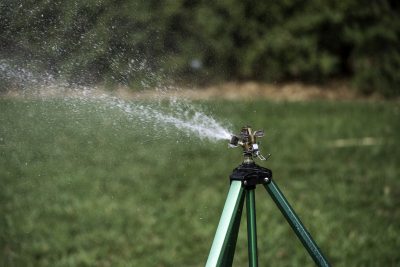By Russell M. Gullo
Beat the heat with these summer gardening tips.
With the hot temperatures we have been experiencing recently, many people are hesitant to
garden. Their concern is that it is not a good time to plant and that anything planted during
the summer will dry up and struggle to survive. While summer does pose its own unique challenges
(just like spring and fall), summer is actually a great time to garden. Following these simple
tips will ensure success and give you the yard you want without having to wait until fall.
Tip #1: Water, Water, Water

Perhaps the most obvious tip, yet the most common cause of plant problems, proper watering
techniques are absolutely essential in summer. Newly planted trees, shrubs, and annuals do not
have the expansive root structure that established plants do, so it is important to water them
regularly and keep a close eye on them until they become established. They will dry up much
more quickly than plants that have been in the ground even only a year. Long, deep, soaking
sessions are preferable to short, superficial waterings. Often times if the soil is dry, it will
become hard and the water will run directly off of it before reaching the plant. Setting up a
sprinkler and letting it run for an hour or more on a newly installed shrub bed will ensure
a deep soaking. For trees, you can place your hose at the base of the tree, turn it on 1/3 to
1/2 of the way depending on water pressure, and let it soak for 30+ minutes. Ample moisture
is also helpful for tomato plants as well to reduce blossom-end rot. A consistent soil moisture,
as opposed to periods of wet and dry, will ensure a healthy crop.
Tip #2: Check for Bugs

Everyone knows about Japanese Beatles, which start as grubs and complete metamorphosis in
summer to wreak havoc on plants. But there are a lot of other bugs, many that are sneakier, to
keep an eye out for. The picture above is of three Graham Blandy Boxwood that I have planted at
my house affected by spider mites. Looking at the plants you would never see these little pests,
but I noticed that the plants were losing some of their dark green color and lacked vigor. I
took a closer look and then treated them with Bonide Fruit Tree Spray. They are now well on their
way to recovery. Another sneaky bug is slugs. They feed at night, so you typically do not see
them during the day, but the damage they can cause is very noticeable. They are especially
fond of hostas. Treating your garden with Ortho Bug-Geta will stop them from eating all of your
hard work.
Tip #3: Don’t Be Afraid to Plant!
Planting in summer allows the roots of trees and shrubs to establish themselves before the winter
hits. Their roots will be much larger the following spring than newly planted trees and shrubs,
giving them a head start the next year. As long as you are vigilant with watering, there is nothing
to fear and your plants will thrive. Often times in Buffalo folks think of summer as “ending” after
the Erie County Fair, however we usually enjoy summer-like conditions for you to enjoy your
landscaping well into October.
Tip #4: Raise Your Lawnmower Blade

Cutting your grass too short in the heat of summer can seriously stress your lawn. Allowing
your lawn to grow higher than normal promotes deep root growth, allowing the grass to reach
deeper into the soil for moisture. It also shades the soil to minimize evaporation from the hot
sun. Never cut more than 1/3 of the height, and keep your blades sharp as well. Dull blades
tear and injure grass blades.
Tip #5: Treat Your Lawn for Weeds

As if your lawn doesn’t get stressed enough from hot, dry conditions, competing for
limited resources with weeds, which can still flourish in these conditions, is even more
stressful. I planted a new lawn at my home in 2016, and it is a process. No matter how well
the planting process is managed, weeds will occur. I like to use Ortho Weed B Gon Chickweed,
Clover, & Oxalis Killer. It is easy to hook up to the hose and do the entire lawn quickly, and it
eliminates most weeds (other than crabgrass, which needs to be spot-sprayed with Ortho Weed
B Gon Plus Crabgrass Control). It is important to note that results are not instant. It takes
about three weeks for the weed to totally shrivel, die, and not be visible. The results are worth
it though with a healthier, more visually pleasing lawn.
Tip #6: Fertilize

Strong, healthy plants are less susceptible to insect damage and fungal diseases, as well as
dying over the winter, so it makes sense to feed them throughout the summer to ensure their
vitality. I like using organic fertilizers this time of year, as they provide a longer, slower
feed and don’t push out as much new growth as synthetic fertilizers. I use Espoma Plant-Tone
on deciduous plants and Espoma Holly-Tone on most evergreens. Both contain Bio-tone®,
Espoma’s proprietary blend of beneficial microbes, which encourage root growth and aids in
nutrient absorption.
Tip #7: Prune and Deadhead

Most perennials and shrubs have a small window in which they bloom, but pruning and deadheading
old, spent blooms can encourage a second blooming period. This is especially true of weigela. And
even if they don’t bloom a second time, you’re left with a neater looking plant. Many hanging
baskets and annuals that don’t shed spent blooms on their own are dependent on occasional
deadheading.








